
 |
|
|
|
The heavens shone on Buenos Aires two years ago when a pair of diligent film curators penetrated decades of bureaucratic roadblocks to unearth a heavily worn but nearly complete original premiere version of one of cinema's most wanted lost treasures, Fritz Lang's monumental fantasy epic, Metropolis. After initial difficulty convincing German experts that their find wasn't just another hoax or a case of wishful thinking, Francisco Martín Peña and Paula Félix-Didier brought proof of their find to Munich. The German magazine Die Zeit sent the news 'round the world. Von Stroheim's Greed and Orson Welles' The Magnificent Ambersons may never be found, but all but one scene and a fragment of another of Metropolis had been recovered. 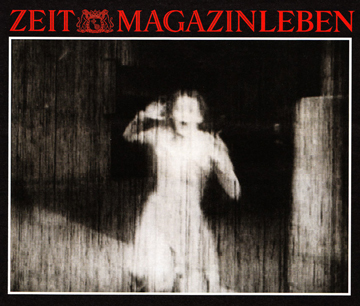
Metropolis was already considered a classic, despite the fact that the version circulating for generations was almost half as long as Lang's intended epic. Explanations of why the film was cut down are now everywhere, removing the need for me to recapitulate that particular cultural crime. Ten years ago, the Friedrich-Wilhelm-Murnau-Stiftung people in Germany undertook a three-year restoration of what remained of Metropolis in the holdings of archives from East Germany to Moscow to Australia; a big chunk of the film came from the abbreviated (polite word) Paramount version re-cut by Channing Pollock only a month or two after the film's premiere. When interviewed Pollock stated that he "had given the film his own meaning", which means that he threw out the plotline and most of the themes written by Lang and screenwriter Thea von Harbou, and wrote his own simplified version. In 2001 the Restored, Authorized Metropolis premiered to popular acclaim. That new version was still missing over a half-hour of footage, presumably lost forever. With the use of continuity notes and timings from the film's original orchestral music score, the archivists were able to plot out the entire movie, including pieces they no longer had. Many expository inter-titles were added to explain missing scenes and sequences. For the first time in 74 years the public could truly see that Metropolis had been a vast and complex epic, and not merely a showcase of grandiose special effects, mob scenes choreographed with architectural precision, and over-the-top expressionist acting. The 2001 restoration was so exacting that when a complete original print showed up from Argentina, some of the work to integrate it into the existing cut was simply a matter of dropping new shots into gaps in the existing continuity. In other parts of the film, the new Buenos Aires negative showed that Lang's editing patterns were different than had been expected. In the final act's big chase, the workers' mob pursues the Good Maria while the False Maria leads a parade of celebrants from the Yoshiwara club. At the same time, Josephat and Freder are racing to rescue the Good Maria. The original Lang cut intercuts these actions into a much more coherent and exciting sequence. 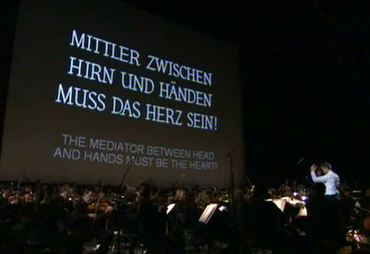
Kino International's The Complete Metropolis Blu-ray and DVD release follows on a series of successful premieres and theatrical bookings. The show has always been a touchstone for film purists, science fiction aficionados and artists inspired by its designs. Viewers unfamiliar with the film will be impressed by the operatic grandeur of its musical accompaniment. With its original orchestral score in place, the movie is once again structured as a series of symphonic movements. Channing Pollock's chop job on Metropolis removed entire characters, trashing Von Harbou's complex pattern of interlocking relationships and themes. Channing's simplified story is about a mad inventor who almost destroys Metropolis with a demonic robot. Neither the inventor nor any of the other characters make the slightest bit of sense. Audiences remember some sensational visuals, an inspired performance (the magical, electric Brigitte Helm) and a sappy ending of capital-labor reconciliation. The 2010 Metropolis is a wondrous parade of themes and ideas meant to represent a futuristic clash between primal social powers -- science vs. mysticism, conformism vs. liberty and an inspired élite against the unwashed mob. Religion leaps into the arena when writer von Harbou makes a privileged son of the city's ruler into a new messiah called "The Mediator". A female prophet predicts the coming of a "social savior" for the downtrodden masses, and sure enough, young born-to-the-silk Freder Fredersen (Gustav Frölich) steps forward and beats his chest in rapture: "It's me!" The plot alternates between inspired ideas and giddy melodramatics. All that the enchanting Maria (Brigitte Helm) need do is bat her silvery blue eyes, and we believe she's the Earth Mother, an exalted and pure hausfrau that can inspire a divine revolution. Freder is suspended between hysteria and a dead faint, as he's infused with the mission (delusion?) that he has been chosen by God to reconcile all differences between the warring societal forces. 1 Freder is so inspired that he can fight off an entire mob with just his two fists. He leaps from his sickbed like Superman, telling his bosom pal Josephat that "Maria's holding an important meeting in the catacombs, and The Mediator ought to be there!" 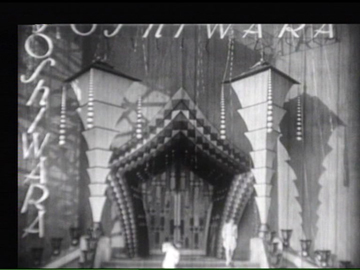
Metropolis reconstituted in its original form is a much more accomplished film than we thought, even after having the "whole structure" laid out for us in the 2001 restoration. With entrances and exits restored, we recognize Lang's signature storytelling shorthand at work. Freder holds up the cap belonging to Georgy, worker #11811. When Lang cuts directly to a long shot of a solitary figure walking down the steps of Yoshiwara, the associative cut tells us that the man on the steps is Georgy, leaving the nightclub/brothel after a night of play. Fritz Lang uses this technique to maintain clarity as he bounces back and forth between parallel plot lines. The associative link allows him to avoid wasting time establishing who we're looking at with each scene change. The full-length Metropolis orchestrates an interesting set of characters, relating opposites to each other in a pattern called "twinning". This structure goes far beyond the "relationship" of the Good Maria to the Machine-Man fashioned in her likeness, a mechanical being without a soul, and therefore Evil. Georgy (Erwin Biswanger) and Freder are also twins from opposite ends of the social scale. Having swapped identities with the blue-blood Freder, the unselfish proletarian Georgy ends up taking a knife for him. The key "twin" relationship is that of Joh Fredersen, the master of Metropolis (Alfred Abel) and Rotwang, the inventor-alchemist (Rudolph Klein-Rogge). Joh and Rotwang had a falling-out over a woman named Hel, who became Freder's mother. Joh thinks he's using Rotwang's Machine-Man to solve a problem of labor revolt, and Rotwang hides what he knows about Freder's love for the worker-prophet Maria. Maddened by the desire for revenge, Rotwang has invented the Machine-Man Robotrix as part of a revenge plot to deprive Joh of his only son. Their mutual distrust cements the tragedy that destroys the city 2 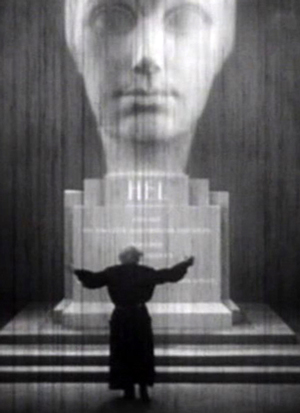
But "new" twin-opposites stand out just as strongly. The spy called The Thin Man (Fritz Rasp) is Joh Fredersen's most trusted agent and Freder's watchdog. When Freder switches identities and disappears, the spy harasses Georgy and Josephat to find him. He must eventually report to Fredersen that his son is somewhere below in the worker's city -- which by that time is supposed to be completely underwater. The Thin Man's opposite number is Josephat, Fredersen's private secretary. He's unfairly fired for not detecting the worker's secret meetings. Ironically, Josephat is the one who sees Freder safely through his subterranean adventures. In a still-missing scene, the Priest in the Cathedral predicts calamity for the city and warns of the coming of an anti-Christ figure, the Mother of Harlots, a.k.a. The Whore of Babylon. The False Maria debuts before society as this Biblical lamia, adding another heavy link to von Harbou's Christian theme - Maria's Tower of Babel sermon has already predicted the fate of the city. The Priest's opposite number is of course The Good Maria, who preaches of the coming of The Mediator. But the Priest is also twinned with Grot (Heinrich George), the engineer who keeps the machines functioning smoothly. The machines make slaves of the workers and, in Freder's first revelatory hallucination, even devour them. But Grot's all-important Heart Machine holds the physical city together; without it the workers would perish. Grot maintains the technological body of Metropolis, while the Priest's religion sustains its spirit. 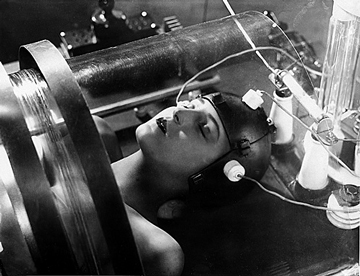
This reviewer was hoping that the nearly complete 2010 restoration would plug a frustrating plot hole in Metropolis, a lack of logic around the actions of the mastermind Joh Fredersen. The executive instructs Rotwang to give the robot Maria's likeness, to undermine the workers' faith in her. Rotwang obeys, but secretly plots to use the "false Maria" to destroy Freder, and bring down Joh's vision of a hereditary dynasty. But when rioting breaks out, Fredersen unaccountably makes it clear that he wants the city ruined. He insists that Grot allow the mob to attack the key power plant, the all-important "Heart" machine. When the power goes out, Joh is not upset, merely interested in seeing the city lights dimmed for the first time. His panic and dismay happens a few seconds later, when he learns that Freder is lost somewhere in the submerged city. Why? The answer is still not certain. Fritz Lang may have left a hole in the story, or the German restorers may have neglected to tell us everything that happens in the still-missing fight scene between Joh and Rotwang. But critic Gordon A. Thomas of Bright Lights Film Journal may have found the key to the mystery. 3 In Thea von Harbou's novelization of her screen scenario, Joh Fredersen wants the city destroyed so his son Freder can rebuild it. I can't imagine how the missing fight scene could break this news, but it's seemingly the only explanation for Joh Fredersen's psychotic, Nero-like behavior. He's just as unhinged as the "mad" Rotwang. Well, plenty of "great men" have held the belief that they possess the divine (or Darwinian) right to be lords over civilization. Already an unwieldy fairy tale of Big Ideas and 20th century -isms, Metropolis agrees with Fredersen, as it has a very low opinion of the workers as a cheap resource unworthy of human rights. They're a brainless mob easily steered by forces good or bad. Maria holds the workers in thrall with simple Bible stories, and the False Maria whips the same group into such a frenzy that it can't be stopped from drowning its own children. Von Harbou's story generates a wave of sentiment for the threatened children, even as it implies that they will grow up to be functionaries unfit for anything better than manual labor. Meanwhile, Freder and Maria seek to deliver the masses with a non-revolutionary Christian message. 
All the preceding is a logical reading of a film that is far more interested in cinematic poetry, on a grand scale: the film's fantastic visuals are as potent as ever. The complete Metropolis restores what might be Fritz Lang's most impressive montage set piece, Freder's hallucination of the society debut of Rotwang's seductive new "discovery". As we've seen, the born-again Freder tends to experience reality through messianic miracle visions. Maria's entrance into the Club of the Sons awakens Freder's heart, and the hallucination of the "Moloch" machine clues him to the truth that Metropolis is founded (and sub-sub- founded) on terrible social injustice. Maria's sermon convinces Freder that he alone is The Mediator. Freder's biggest hallucination occurs after his visit to the Cathedral where he hears the Priest's sermon (a missing fragment) and sees the statues of the Seven Deadly Sins. When Freder collapses, after seeing what he thinks is Maria embracing his father (does Freder have Father issues?), all of these elements meld with his "remote viewing" of The False Maria's debut. Freder experiences the audience's lust for Maria's erotic dance. He hallucinates that The Thin Man transforms into the Priest, and repeats his sermon about the Whore of Babylon. On cue, the Seven Deadly Sins come to life. In this new cut the Sins now replace the 'Nubians' bearing the Whore's throne. Maria "is" the Whore in Freder's dream, a horror-vision followed by the specter of Death with his scythe. Finally intact, the montage is simply incredible, a kinetic assault of carefully prepared images that express the emotional forces tearing away at Freder. Rendered almost completely without text, this montage is one of the most creative pieces of film I've ever seen. And to think that the erotic dance montage once existed only as a few random shots that made very little sense. The "old" cut-down version needs to be preserved, just to appreciate what was lost. 4 Besides the Priest's sermon and the big fight between Fredersen and Rotwang, there are still a couple of missing bits from the new Argentine footage, that the experts have identified as censor cuts. Both have to do with the sensual pleasures to be found in Yoshiwara. Newly liberated from the torture clock, Georgy crosses Metropolis in Freder's limousine, staring in wonder at the glamorous surface world he's never before seen. An alluring woman pulls up in the next lane and Georgy gawks at her. But a Jump Cut remains where a cutaway to the woman has been removed. Georgy's eyes widen, but we don't know what he saw. A comparison of the woman before and after shows that the shoulder strap of her gown has fallen; perhaps the missing scene showed her suggestively lowering it, as a flirtatious come-on. An advertising flyer for Yoshiwara grabs Georgy's attention, cueing a short montage of the sensual delights to be found in the pleasure club: music, liquor, and attractive women of all races. In the middle of the kaleidoscope of imagery appears the figure of a woman, who begins to open her cape. The shot Jump-Cuts ahead a foot or two, apparently removing the reveal of the woman inside the cape, dressed in some way unacceptable to the Argentine censors. 
I was present when the short version of Metropolis was screened in a UCLA class back in 1974. When the lights came up, the instructor (it might have been Bob Epstein or Stephen Mamber) introduced... Fritz Lang himself. He lived only a few minutes away. Lang had someone to help him about, as he was almost blind. He spoke only for a few minutes and didn't say much because few of the undergraduates in the film class had seen many of his movies! Afterwards Lang sat on a bench outside Melnitz Hall and about ten of us gathered around to hear him talk. He was still interested in crime movie ideas and movies about morality. He claimed not to be interested in Metropolis any more and even said that it was a failure because of the script's silly ending. There was no discussion about how he made the movie, as he looked tired and soon excused himself. Of course, nobody knew to ask him if the show had ever been longer; we all assumed that what we saw was all there was -- the silent film prints that were screened in our classes were often difficult to make heads or tails of. And that's my big Fritz Lang story. He was frail and wore a messy-looking eye patch behind his glasses, but he was very clean! His helper walked him to his car. The progression of Metropolis from ragged 16mm remnants, through various restorations that seem to add a little more footage, has been amazing. The Argentinian discovery is truly a miracle, and a major gift for film culture. 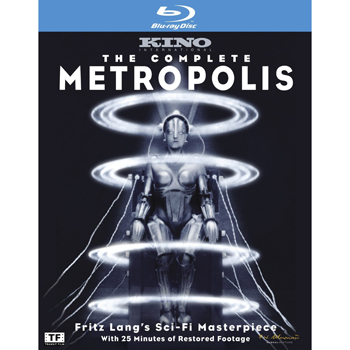
Kino International's Blu-ray of The Complete Metropolis (also available in Standard DVD) is a good encoding of film materials that range from perfect-quality footage to the grossly flawed but still watchable new material from Buenos Aires. As should be obvious, it's amazing to finally know that the sequence of shots one is seeing is indeed how Fritz Lang cut the film back in 1926, and not a restorer's best guess. The Blu-ray transfer is wonderfully stable and sharp, and limited only by the fact that the German restoration scans were done at 2K, a scan rate now considered minimal. Some fades look a tiny bit rough, but they looked that way projected on a large screen as well (I don't know if 35mm film prints were made for the theatrical release). Viewers wondering if they'll be able to tell which new scenes are new can rest easy. The recovered 16mm negative was reduction-printed from a 35mm nitrate print that had been thoroughly thrashed. Although unbroken (except for two sections lost at the beginning and ending of reels) every kind of film damage known to man had been visited on the print. Digital restoration expert Thomas Bakels describes the scratches as a "constant rainfall". The entire print had been soaked in projector oil, which left a constant pattern of blotches on the image. The restoration work by Bakels' Alpha-Omega digital company has eliminated more than half of these flaws and stabilized the image to a degree that enabled it to be re-integrated with the "good" footage. You'll note that all of this new footage has black bars running down the left side and across the top. The 16mm reduction copy was made in such a sloppy manner that it simply masked off areas where a 16mm optical track and fat frame line would normally appear. The image has been kept at its proper proportions to match the footage around it. 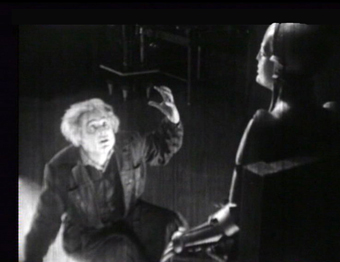
Kino International is the American distributor for the restoration, which is controlled by its German rights holders. So the extras on the Kino disc were dictated from abroad. For several American showings, the Alloy Orchestra provided an amazing and unusual musical accompaniment; I saw their performance at the Grauman's Chinese "North American Premiere" and loved their use of weird metallic sounds as well as their choice of hard-edged '20s themes for the nightclub scenes. Alloy's founder Ken Winokur has said that his group's music was recorded for use as an alternate track on the DVDs, but the original authorized orchestral track by Gottfried Huppertz is the only one on the Blu-ray and DVD. The Germans have provided a 50-minute documentary telling the film's restoration history from the archivists' point of view, Voyage to Metropolis. It's in HD and includes interviews with most everybody involved in earlier restorations, including one in 1972 in East Germany. Other scenes bring in a discussion of architecture -- Fritz Lang was a schooled and trained architect and the film reflects some of the new German design movements of the 1920s. Argentine curator of Buenos Aires' Museo del Cine Paula Félix-Didier appears in an interview taped when she visited New York for the East Coast premiere of the restoration. Ms. Félix-Didier has been seen in several interviews and documentaries by now; hopefully this find will bring needed funding to her archive. One needs to read between the lines in articles and interviews to realize that archive work is just as political as any other field. Ms. Félix-Didier and her partner were for years prevented from accessing what they suspected to be a "special" copy of Metropolis. What is politely called a bureaucratic roadblock usually boils down to competing egos and jealous territoriality: read Fernando Martín Peña's article Metropolis Found. Also, I've seen precious little coverage of the digital work done to revive that horrendously flawed rediscovered negative. Had Alpha-Omega digital and its vendors not been able to work miracles with this material, the chances are that the restoration would have been limited to creating a curio suitable only for film study. As it is, with just a little leeway for the degraded quality of the new scenes, The Complete Metropolis is a knockout cinematic experience. The 2010 Theatrical trailer is included as well. The cover sleeve is a lenticular "3D" image of the Robotrix on her throne. What an amazing design concept -- a sexy naked metallic woman. Most of the wonders of Metropolis are mechanical and electrical: the power machines, the television, the cogs and wheels of the title sequence. This sensuous, shape-shifting Maschine-Man is also a creation of alchemy, as indicated by the presence of an inverted pentagram. The Robotrix is therefore a Clockwork Golem. She brings to futuristic technology an erotic tension, perhaps for the first time in the movies. It's the birth of modern science fiction filmmaking. This is DVD Savant's umpteenth review, posting or article on Metropolis. Here are the others: 
My first article (1999) comparing Metropolis to Star Wars, Sorting out the Pulp. It has some early grousing on my part as to the lack of anything like a complete version, and even gripes about the film's projection speed!
The truly obsessive can check out more of Savant's coverage: Thomas Bakels' Alpha-Omega digital Showroom on Metropolis has several full-video before & after demonstrations of the digital cleansing required to make the Argentine footage viewable. Remember to access the pages "Image Restoration" and "Reconstruction". My new article lets digital restoration specialist Thomas Bakels discuss his new software advances used to "heal" the new scenes for the film, Notes on the 2010 restoration.
And don't forget Aitam Bar-Sagi's above-mentioned research page on Metropolis Around the World.
On a scale of Excellent, Good, Fair, and Poor,
The Complete Metropolis Blu-ray rates:
Footnotes:
1. Quick, somebody get Freder Fredersen to perform his handshake miracle in the U.S. Congress.
2. The intense Thea von Harbou, Lang's wife, may have been airing her personal demons in her screenplay. In real life von Harbou was married to Klein-Rogge before she defected to marry Lang ... just as the beloved "Hel" left Rotwang to marry Joh. So von Harbou effectively envisions herself as a feminine ideal, with a giant statue erected in her honor! I hope an old girlfriend never makes a movie about me, and if she does, I certainly won't play her version of myself. These exalted Weimar visionaries must have thought themselves the equivalent of gods at play. At least they had talent!
3. As Mr. Thomas will be writing up his thoughts on this issue on his own, I've kept my remarks brief. (note, 2.15.11: Gordon Thomas' Bright Lights essay, with a brilliant analysis of the missing Joh Fredersen motivation, is now available to be read here.)
4. The experts say that Metropolis was never designed or intended to be another massive two-part epic, like Fritz Lang's previous success Die Nibelungen. Long-time Metropolis researcher Aitam Bar-Sagi has compiled a page of information about the film's many different versions as released in different countries, Metropolis Around the World. Here we learn than in the Netherlands the film was released in two parts, possibly to maximize the box office take. The halves were given secondary chapter titles: The Modern Babylon and The False Maria. Yet The Complete Metropolis, at first glance, divides very nicely into two movies. If one splits the present film in two immediately after The False Maria's debut, the next scene of Josephat visiting the recovering Freder is perfect for the beginning of a "second chapter" -- we even see a brief recapitulation of the erotic dance scene. It's not difficult to imagine Lang envisioning, at least at the beginning, an even longer Metropolis. It could have sustained more plot complications, perhaps straightening out the fumble dealing with Joh Fredersen's motivations. Part One could conclude with a preview of Part two, and Part Two could begin with an even longer recap. I stress that this is idle speculation and not to be confused with an expert opinion.
Reviews on the Savant main site have additional credits information and are often updated and annotated with reader input and graphics. Also, don't forget the 2010 Savant Wish List. T'was Ever Thus.
Review Staff | About DVD Talk | Newsletter Subscribe | Join DVD Talk Forum |
| ||||||||||||||||||